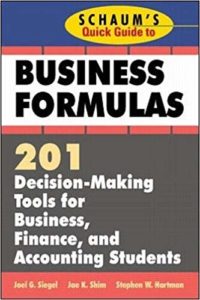I’ve had this ‘Business Formulas’ book sitting around for years. I decided to explore the learning curve formula: (a) create it in Excel and (b) think about the factors that go into learning Excel.
What is the Learning Curve?
It’s based on the proposition that labor hours decrease in a definite pattern as labor operations are repeated….based on the statistical finding that as cumulative production double, cumulative average time required per unit will be reduced by some constant percentage, ranging typically from 10% to 20%
This quote is from the book “SCHAUM’s BUSINESS FORMULAS”
In other words The more you learn the easier it gets.
Well…kind of. More on this later.
Excel File
In this Excel file I converted the formal equation into a formula:
=$F$24*($F$3)^(LN(E25)/LN(2)) this formula can described as:
=Unit Time Hours*(Learning Curve Percent)^(LN(Unit Value)/LN(2))
- Unit Time Hours total hours to complete the first unit.
- Learning Curve Percent or the improvement rate.
- ^(LN(Unit Value)/LN(2)) calculates like compound interest.
See columns E and F. At the top I used a simple method to reduce the value above by the same learning curve percent. Below that I used the formula described above.
What Affects Rate of Learning Excel?
- The Learning Curve is used for economics & accounting. Can we apply it to Excel?
- When learning Excel what influences (a) Learning Curve Percent, (b) Unit Time Hours?
- Can we reduce these components down to simple terms?
Let’s consider the following:
- Learning Curve Percent =quality of the training material + necessity + curiosity
- Unit Time Hours =effort
High quality training definitely accelerates learning.
For me, necessity & curiosity are incredible factors in the learning process.
By necessity I learned T-SQL in my last job. I enjoyed it but had to learn quickly and stay focused.
I’ve learned most of my vba due to curiosity. The “I wonder if it’s possible to…” has been a huge factor.
Effort (grit) is an incredible factor. Without it nothing else matters.
Decrease Learning Curve Percent
If we can decrease our learning curve percent we’ll learn faster!
How can we do that?
- Find the material that works for you
- Practice. Build stuff (necessity helps!)
- Get help (don’t forget what you learn!)
- Repeat & Improve (it gets easier)
If we don’t improve the percent will remain close to 1. See sheet ‘Learning Curve Percent’.
About Me
My name is Kevin Lehrbass. I’m a Data Analyst. I live in Markham Ontario Canada.
My Data Learning Curve started back in the late 1990s. I saw someone working in Excel and it intrigued me. I read a book and took a course. Then I read the Excel 2000 Bible by John Walkenbach cover to cover! In 2001 I started my first data job, learned SQL, took more courses, read more books… and the rest is history.
But…we have to keep using our skills or we’ll forget. My T-SQL (and PL-SQL) skills have dropped off because I haven’t used it in 10 years (I still use SQL). My Excel and DAX formula knowledge have increased. I still play around with VBA and it does come in handy but it’s not an essential part of my current job.




